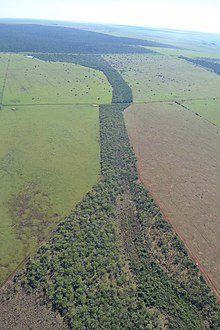
A wildlife corridor, also known as a habitat corridor, or green corridor,[1] is an designated area that connects wildlife populations that have been separated by human activities or structures, such as development, roads, or land clearings. These corridors enable movement of individuals between populations, which helps to prevent negative effects of inbreeding and reduced genetic diversity, often caused by genetic drift, that can occur in isolated populations.[2] Additionally, corridors support the re-establishment of populations that may have been reduced or wiped out due to random events like fires or disease. They can also mitigate some of the severe impacts of habitat fragmentation,[3] a result of urbanization that divides habitat areas and restricts animal movement. Habitat fragmentation from human development poses an increasing threat to biodiversity, and habitat corridors help to reduce its harmful effects.
- ^ "Planning Portal – Glossary: G". Archived from the original on 1 December 2008.
- ^ "University of Michigan Dearborn Library Catalog - Database Authentication Screen". wizard.umd.umich.edu. doi:10.1111/mec.14806. Retrieved 4 October 2024.
- ^ Bond, M. (2003). "Principles of Wildlife Corridor Design. Center for Biological Diversity" (PDF). Biologivaldiversity.org. Archived (PDF) from the original on 6 June 2022. Retrieved 11 August 2015.